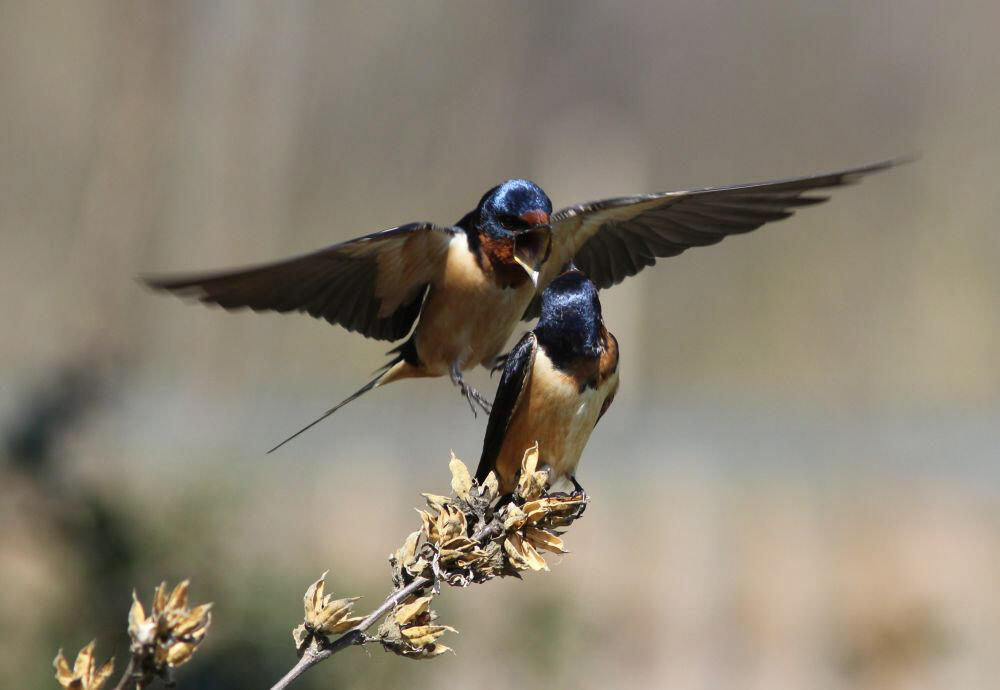By Dr. Richard Gibbons, Director of Conservation
Uncertainty, it’s the prevailing mood for many. It’s in our headlines, our workplaces, our daily lives. In the conservation community, we understand uncertainty. We live it.
As I was leaving the house recently, a very familiar Barn Swallow caught my attention, energetically calling to its extended family and crisscrossing the sky with deft turns and dives, an absolute master of the air.
This Barn Swallow migrated back to our neighborhood from the tropics not too long ago. This Barn Swallow gave me hope. Maybe that day I saw hope everywhere.
Our street was a cattle pasture just a few years ago, decidedly not Barn Swallow nesting habitat. They like covered overhangs for their mud nests. Every year they make an epic journey from South America, navigating storms, predators, and disappearing habitats. That journey is full of uncertainty. When these houses went up, the Barn Swallow was primed to see the new nesting sites.
This very determined long-distance migratory bird saw the opportunity. That’s a lesson we need – right now.
Change is constant. Here’s a truth that I think we need to remember, especially in Texas, where change is seemingly moving especially fast; nature is not fixed. It’s dynamic. Fluid. Constantly reinventing itself. What we’re conserving is not a museum exhibit. It’s a living breathing system in motion.
Nature is different today than it was yesterday—and it will be different again tomorrow. And maybe that can be a comfort. That change is certain, even when everything else isn’t.
Big Dreams, Big Shifts. I’m a Gen Xer, born in the ‘70s. We grew up dreaming big—moon colonies, dolphin translators, world hunger eliminated, flying cars, limitless energy.
I had doubts about the flux capacitor—but still, the vision was bold.
Now? We can sequence a human genome in five hours. We carry supercomputers in our pockets. We can record the sound of a bird and identify it in seconds—and instantly share that data with scientists and birders around the world.
That technology has fueled an explosion in community science. Birdwatching alone has more than doubled since 2016—over 96 million Americans now identify as birders.
That’s not just a hobby. That’s a force. A force collecting data, creating awareness, shaping conservation.
The Sobering Truth, the State of the Birds. And yet, despite all this progress, the 2022 State of the Birds Report brought us hard news; since 1970, North America has lost nearly 3 billion birds. That’s one in four birds—gone.
Nearly every habitat showed declines. The only bright spot? Wetlands. And even that changed with the 2025 report2025 State of the Birds Report. What made wetlands different—at least for a time—was investment, and collaboration: decades of it, across sectors, across agencies, across boundaries.
In conservation, we often work within three overlapping strategies: Reserve, Restore, and Reconcile.
Reserving is about protecting what’s left. Through national parks, land trusts, tribal lands—it’s the work of saying: "This place matters. It stays."
Restoration takes what’s been degraded and revives it. Here in Texas, we see it in the pines of East Texas where Red-cockaded Woodpeckers thrive again. In the Balcones Canyonlands where Golden-cheeked Warblers are singing this morning. In the return of Desert Bighorn Sheep to Big Bend.
These first two Rs, Reserve and Restore, are essential—but they’re not enough.
The third R, Reconciliation, may be the most critical of all. Because it asks us to find harmony in the spaces where people and nature must co-exist. It asks us to be creative in cities, in working lands, in our backyards. This is where we can make enormous gains. Reconciliation is about the path forward. To reconcile is to find a new path ahead—to seek harmony between humans and the rest of the living world.
Take the Bird City Texas program. It brings together municipalities, nonprofits, and volunteers to make cities more bird- and people-friendly—because 96 million birders want to live somewhere that celebrates biodiversity.
Or the Audubon Conservation Ranching program. It helps ranchers restore grasslands for birds like the Eastern Meadowlark—whose population has plummeted. Three of four Eastern Meadowlarks are gone. By supporting native grasses, soil health, and water retention, we help birds, provide critically important ecological services, and the rancher’s bottom line.
And when you listen to these ranchers talk about how the land has come back to life, it’s not just about economics. It’s about legacy.




